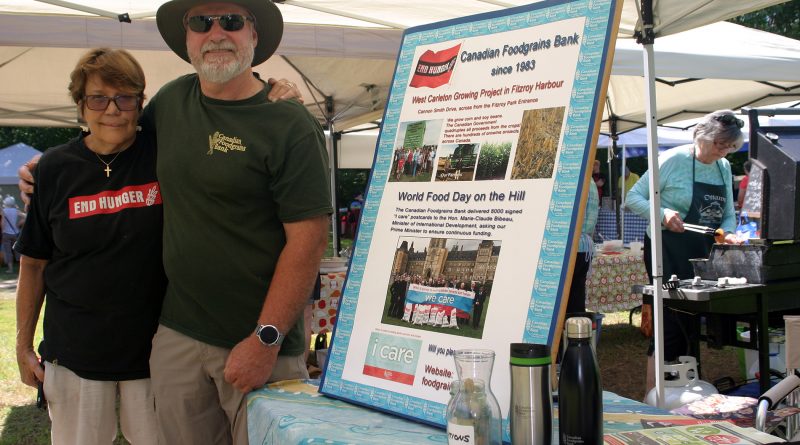WC’s foodgrains bank feeding the globe
CONSTANCE BAY – A pair of West Carleton farming brothers who wanted to help feed the world, have grown their project in to the successful West Carleton Foodgrains Bank Growing Project.
About 10 years ago (2009) Fitzroy Harbour’s Gary Weir and his brother Ron took a portion of their cropland and have turned it in to a yearly donation to the Canadian Foodgrains Bank that has now totaled more than $70,000 in donations to a program that’s lofty goal is to end hunger.
West Carleton Online ran in to Gary and Lisa Probst at the Constance Bay Community Market on Saturday, June 13. The two run a small kiosk collecting donations and sharing information on the Canadian Foodgrains Bank which is a Christian organized response to global hunger.
“It was my brother who first got interested,” Gary told West Carleton Online. “He thought it would be a nice idea to take a small portion of the income off our crop and donate it to the foodgrains bank.”
There were already foodgrains bank projects in nearby Almonte and Arnprior but, at the time, none in West Carleton.
The brothers took a four-acre portion of their cropland near Fitzroy Provincial Park, grew soybeans, sold them at market and raised about $600 that first year.
“Ronnie was interested in getting our church involved,” Gary said.
They approached their church, St. George’s Anglican Church in Fitzroy Harbour and their project grew.
“We decided to do it as a parish project,” Gary said.
Their project continued to grow. The St. Thomas Anglican Church in Dunrobin got involved and Probst signed up and now plays a major role in raising awareness of the project and seeking partners. Probst helps out at the Constance Bay booth and organizes a booth at the Carp Farmers’ Market once a year as well as taking any other opportunity to raise awareness she can find. Probst also acts as the Primate’s World Relief and Development Fund representative for the West Carleton foodgrains bank.
About six years ago Gary was attending an event at the Anglican Christ Church Bells Corners, and all of a sudden that parish wanted to help. Now the Bell’s Corners church raises about $2,000 each year which the Weirs use for input costs such as fertilizer.
Not long after that, St. John’s South March Anglican Church wanted to help out. They annually donate around $500. As word of the project crew, more partners came aboard.
Bit-a-Luk Farm in Carp got involved and provides seeds each year. Gary says those seeds can cost as much as $3,500 to buy annually. Synagri has also joined the project and provides weed control for the farmers.
The cropland has also increased as the Weirs now donate 25 acres of farmland where they rotate soybeans and corn crops each year, donating the proceeds of the crops to the foodgrains bank. The last few years the West Carleton Foodgrains Bank has been able to annually donate $10,000 to help end hunger. On top of that, the Canadian government quadruples all foodgrains bank proceeds up to $25 million a year.
“I’ll say that when my brother tried to convince me at first, I wasn’t fully invested,” Gary said. “Over time I have seen how important it is. The people involved are very committed.”
Rather than donating the crops directly to those who need food, the Canadian Foodgrains Bank learned over time it was much more cost-effective for the food producers to sell the crops themselves and donate cash to the project.
“I usually sell the crops right away,” Gary said. “I don’t store it unless the prices are really bad.”











Pingback:WC Online’s top July stories – West Carleton Online